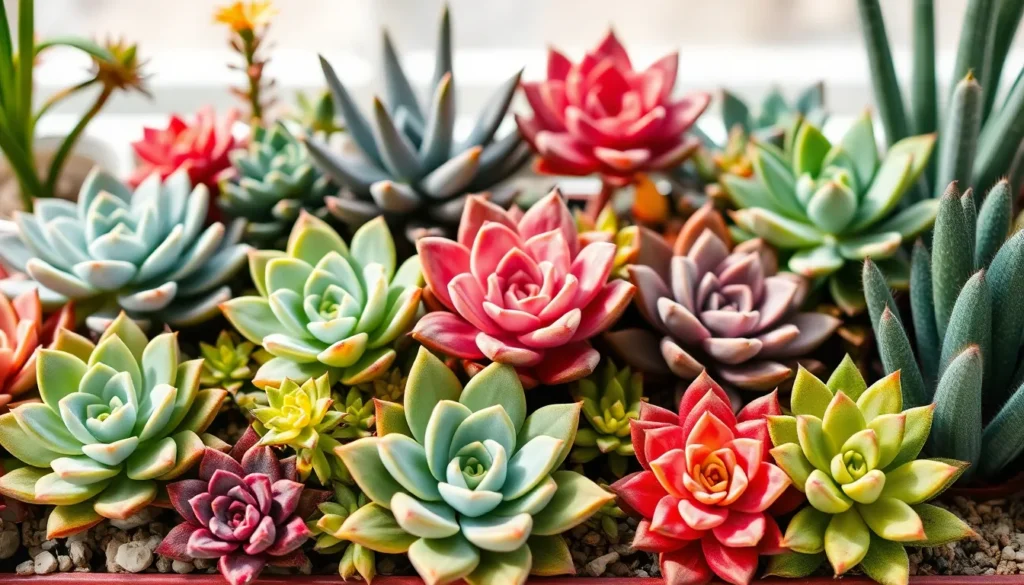Succulents have taken the gardening industry by storm and it’s easy to see why. These remarkable plants store water in their thick fleshy leaves and stems making them incredibly low-maintenance while delivering stunning visual appeal. Whether you’re a seasoned plant parent or just starting your green journey we’ve got you covered with the ultimate guide to succulent varieties.
From the classic rosette shapes of Echeveria to the architectural beauty of Aloe plants the industry of succulents offers endless possibilities for every space and style. We’ll explore the most popular types that thrive indoors and outdoors helping you discover which varieties suit your lifestyle best.
Ready to transform your space with these drought-tolerant beauties? Let’s jump into the diverse industry of succulent plants and find your perfect match.
Echeveria: The Rose-Shaped Beauties
Echeveria succulents captivate gardeners with their perfect rosette formations that resemble blooming roses. These Mexican natives offer stunning variety in colors and textures while maintaining the low maintenance characteristics that make succulents so appealing.
Ghost Plant (Echeveria Lilacina)
Ghost Plant earns its ethereal name from the pale blue-gray leaves that seem to glow in sunlight. This stunning variety grows up to 6 inches wide and produces delicate pink flowers on tall stalks during spring months. We love how the powdery coating on its leaves creates a frosted appearance that’s both beautiful and functional.
Caring for Ghost Plant requires minimal effort since it tolerates drought conditions exceptionally well. Place this beauty in bright indirect light and water sparingly when the soil feels completely dry. The plant’s compact size makes it perfect for container gardens or rock garden displays.
Hens and Chicks (Echeveria Elegans)
Hens and Chicks produces abundant baby plants around its base, creating charming clusters that spread naturally over time. The mother plant (hen) develops many smaller rosettes (chicks) that you can easily separate and replant elsewhere. This prolific grower features silvery-blue leaves with delicate pink edges that intensify in cooler weather.
Growing Hens and Chicks successfully means providing excellent drainage and avoiding overwatering at all costs. We recommend planting this variety in well-draining cactus mix and positioning it where morning sun reaches the leaves. The plant’s hardy nature allows it to survive light frosts, making it suitable for outdoor cultivation in many climates.
Black Prince (Echeveria Black Prince)
Black Prince stands out with its dramatic dark purple leaves that appear almost black in intense sunlight. This compact variety grows slowly to about 3 inches across and develops stunning burgundy flower spikes in late fall. We find this gothic beauty particularly striking when planted alongside lighter colored succulents for maximum contrast.
Maintaining Black Prince requires bright light to preserve its signature dark coloration since insufficient light causes the leaves to turn green. Water deeply but infrequently, allowing the soil to dry completely between waterings. This variety thrives in temperatures between 65-75°F and benefits from occasional feeding with diluted succulent fertilizer during growing season.
Sedum: The Ground-Covering Champions
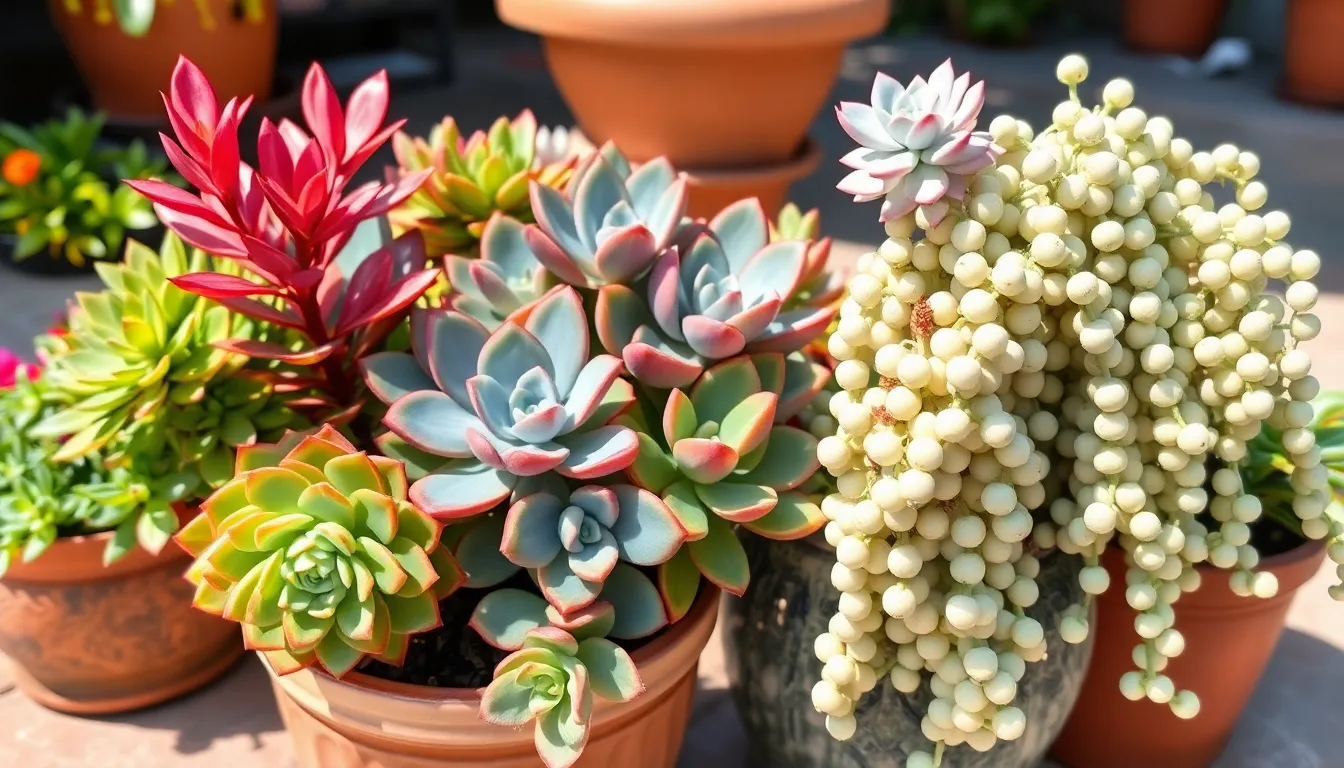
Sedum varieties stand out as some of the most adaptable succulents we’ll find in any garden collection. These hardy plants thrive in diverse climates and offer stunning visual appeal while requiring minimal maintenance.
Jade Plant (Sedum Rubrotinctum)
Jade Plant captivates us with its adorable bean-shaped leaves that transform from green to vibrant red in bright sunlight. Commonly called the “Jelly Bean Plant,” this charming variety produces small, chubby foliage that creates an eye-catching display in any indoor space. We love how easy it is to care for this succulent, making it perfect for beginners who want instant satisfaction. Bright light encourages the stunning reddish coloration that makes this plant so desirable among collectors.
Burro’s Tail (Sedum Morganianum)
Burro’s Tail mesmerizes us with its cascading stems covered in plump, pale blue-green leaves that perfectly resemble a donkey’s tail. This trailing variety works beautifully in hanging baskets where its stems can drape gracefully over the edges. We recommend placing it in bright, indirect sunlight to maintain its healthy appearance and prevent leaf drop. Its dense foliage creates a stunning waterfall effect that adds dramatic texture to any room or patio space.
String of Pearls (Sedum Lineare)
String of Pearls enchants us with its unique bead-like leaves that grow along thin, trailing stems. These small, round leaves create an elegant cascading effect that works wonderfully in hanging containers or as decorative ground cover in warmer regions. We appreciate how versatile this variety proves to be, thriving both indoors and outdoors depending on our climate conditions. Its delicate appearance belies its hardy nature, making it an excellent choice for adding sophisticated texture to our succulent arrangements.
Aloe: The Healing Wonders
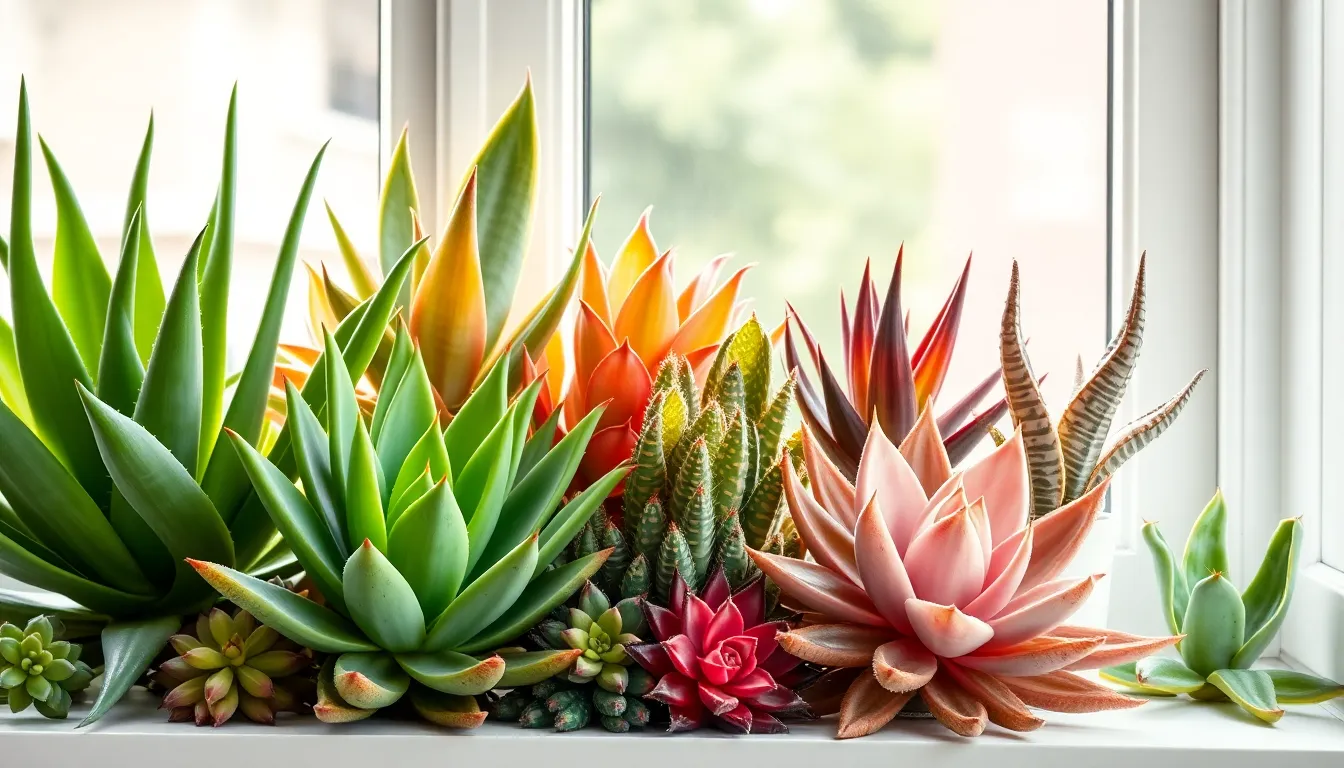
Moving from the colorful industry of Echeveria and hardy Sedum varieties, we encounter the remarkable Aloe genus, where beauty meets wellness in nature’s most therapeutic succulents.
Aloe Vera (Aloe Barbadensis)
Aloe Vera stands as the most celebrated healing succulent in our gardens today. We recognize this medicinal powerhouse for its gel-filled leaves that treat skin conditions, burns, and minor wounds with remarkable effectiveness. Growing this therapeutic plant indoors becomes effortless when we provide warm, sunny environments that mimic its natural habitat.
The thick, fleshy leaves of Aloe Vera store both water and healing compounds, making it a dual-purpose addition to our succulent collections. We find this member of the larger Aloe genus thrives with minimal care while offering maximum benefits for our health and wellness routines.
Zebra Plant (Haworthia Fasciata)
Zebra Plant captivates us with its distinctive white horizontal stripes across dark green leaves, creating a striking zebra-like pattern that adds visual interest to any space. While not technically an Aloe, we group this Haworthia fasciata with similar succulents because of its appearance and identical care requirements.
This compact succulent remains small and drought-tolerant, making it perfect for our decorative houseplant arrangements. We place our Zebra Plants in areas with indirect sunlight and water them minimally, watching as they maintain their stunning striped appearance year-round.
Tiger Tooth Aloe (Aloe Juvenna)
Tiger Tooth Aloe earns its fierce name from the spiky, toothed edges of its leaves that resemble a tiger’s fearsome teeth. We appreciate this smaller, shrubby succulent for its ability to produce offshoots, making propagation simple and rewarding for expanding our collections.
Aloe Juvenna prefers bright light without harsh direct sun, reflecting its semi-shade natural habitat preferences. We position these plants where they receive filtered light while benefiting from their traditional medicinal uses, though less extensively studied than their Aloe Vera cousins.
Crassula: The Thick-Leaved Varieties
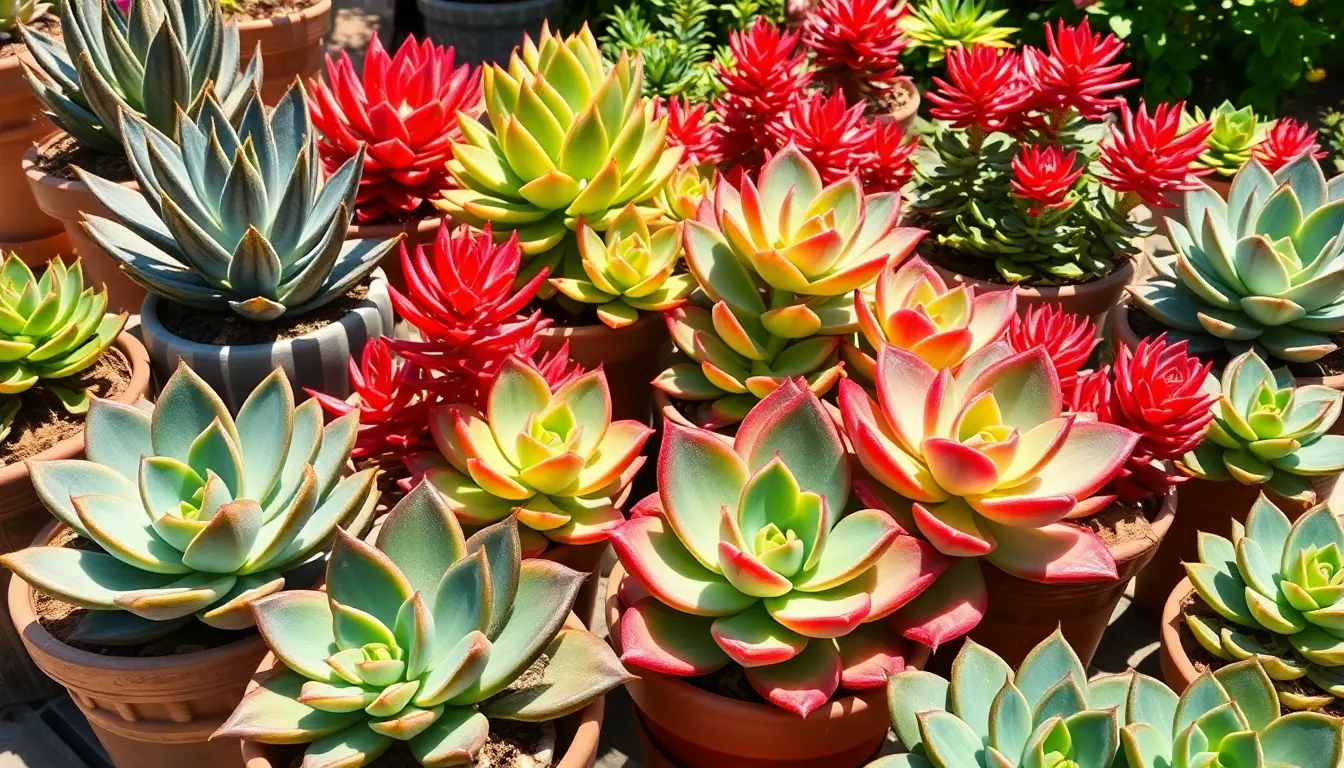
We discover some of the most beloved thick-leaved succulents in the diverse Crassula genus. These water-storing plants showcase remarkable adaptability and striking visual appeal that makes them perfect for both indoor and outdoor collections.
Jade Tree (Crassula Ovata)
Jade Tree stands as one of the most popular and widely cultivated succulents worldwide. This remarkable plant, also known as the “money tree,” features glossy oval-shaped leaves that store water efficiently in their thick, fleshy tissues. The bright green foliage often develops stunning red edges when we expose it to sufficient sunlight, creating a beautiful contrast that enhances any space.
Growing several feet tall, this tree-like succulent develops a sturdy trunk and branching structure that mimics traditional trees. We find it thrives both indoors and outdoors in mild climates, making it incredibly versatile for different growing conditions. The plant’s reputation for bringing good fortune has made it a favorite gift among plant enthusiasts.
Care becomes remarkably simple with Jade Trees since they tolerate neglect better than most houseplants. Watering every 2-3 weeks during growing season and monthly in winter keeps these succulents healthy and thriving.
String of Buttons (Crassula Perforata)
String of Buttons creates an eye-catching display with its unique stacked leaf arrangement. The triangular leaves appear threaded together like beads on a vine, forming distinctive geometric patterns that captivate viewers. Each thick leaf features green centers with red-tinted edges that intensify under bright light conditions.
Trailing growth habits make this variety perfect for hanging baskets or cascading over container edges. We love how the stems create flowing curtains of succulent foliage that add vertical interest to any succulent arrangement. The perforated appearance of leaves gives this plant its common name and distinctive visual appeal.
Propagation happens easily when stem segments root quickly in well-draining soil. Light requirements remain moderate, though bright indirect light enhances the red coloring along leaf margins.
Red Pagoda (Crassula Capitella)
Red Pagoda delivers dramatic color transformation that rivals any flowering plant. The sharply triangular leaves stack in layered formations that create stunning pagoda-like structures rising from compact rosette bases. Under strong sunlight exposure, leaves turn brilliant red or deep pink, transforming this succulent into a colorful focal point.
Upright growth patterns make Red Pagoda ideal for creating height variation in succulent gardens and arrangements. We observe how the geometric leaf stacking creates architectural interest that complements both modern and traditional garden designs. The compact rosette form keeps plants manageable while providing maximum visual impact.
Color intensity depends directly on sunlight exposure, with more light producing deeper red hues throughout the foliage. These succulents prefer bright conditions and well-draining soil that prevents root rot while encouraging vibrant coloration.
Aeonium: The Tree-Like Rosettes
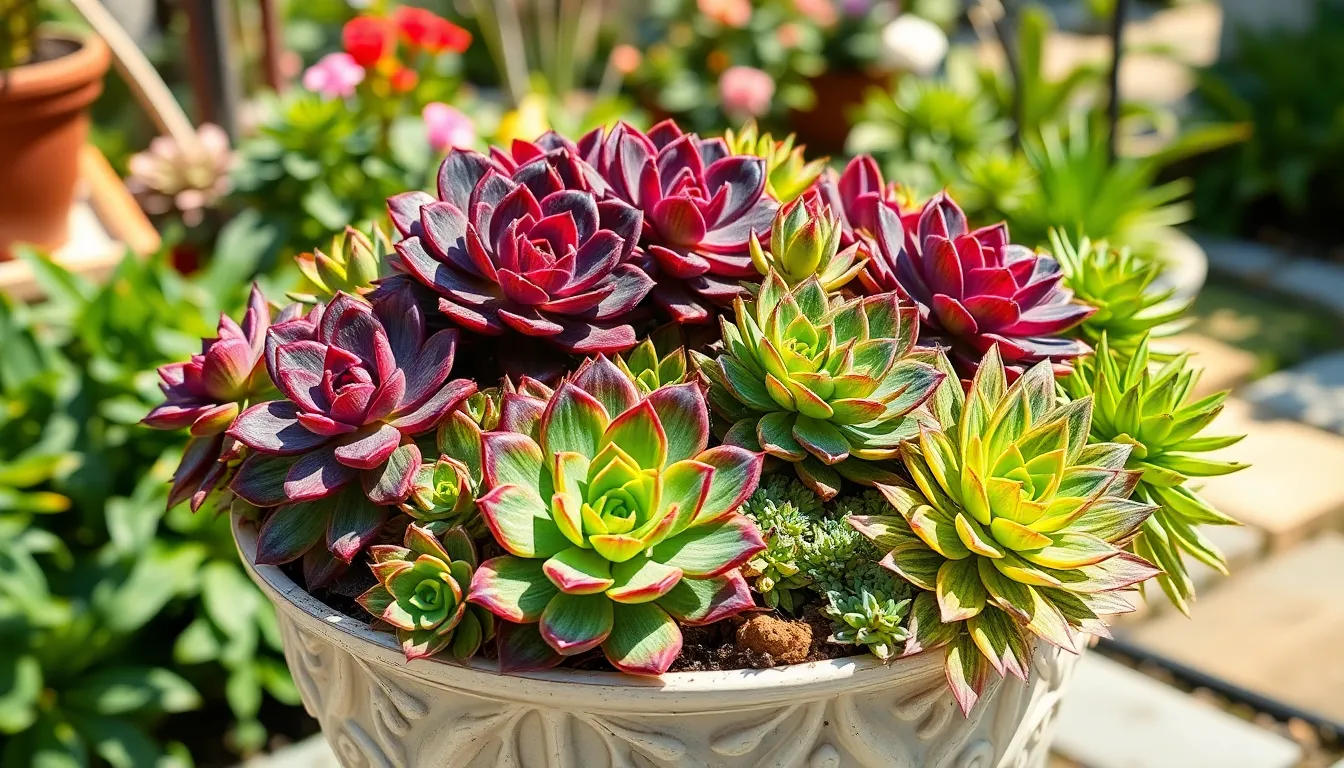
Aeoniums bring architectural beauty to succulent gardens with their distinctive rosette shapes and branching growth patterns. These members of the Crassulaceae family create stunning visual displays as they develop woody stems that support their signature rosette formations.
Black Rose (Aeonium Arboreum)
Black Rose succulents captivate collectors with their dramatic dark purple rosettes that appear almost black in bright sunlight. We’ve found this variety develops into small tree-like specimens as it matures, creating branching stems that support multiple rosettes. The ‘Zwartkop’ cultivar produces the deepest coloration when grown in bright light conditions.
Growing requirements remain straightforward for this striking specimen. Bright light exposure intensifies the dark coloration while preventing the rosettes from becoming too pale. We recommend providing excellent drainage since waterlogged soil can quickly damage the roots.
Pinwheel (Aeonium Tabuliforme)
Pinwheel aeoniums create spectacular flat rosettes that spread horizontally like dinner plates across the growing surface. This unique growth pattern sets them apart from other aeonium varieties, as they maintain their low profile rather than developing tall stems. Their rosettes can reach impressive diameters when given adequate space and proper care.
Light requirements differ slightly from their tree-like relatives. Moderate light conditions work best for maintaining the characteristic flat formation. We’ve noticed that too much direct sunlight can cause the edges to burn, while insufficient light leads to loose, stretched growth.
Sunburst (Aeonium Decorum)
Sunburst aeoniums display gorgeous variegated foliage with creamy yellow edges surrounding green centers in each rosette. This slower-growing variety develops compact rosettes that maintain their striking color patterns throughout the growing season. The variegation becomes more pronounced when plants receive optimal growing conditions.
Partial shade protects the delicate variegated leaves from burning in intense sunlight. We prefer morning sun with afternoon shade for the best color development. Good drainage remains essential, as these slower-growing specimens are more susceptible to root rot than faster-growing varieties.
Kalanchoe: The Flowering Succulents
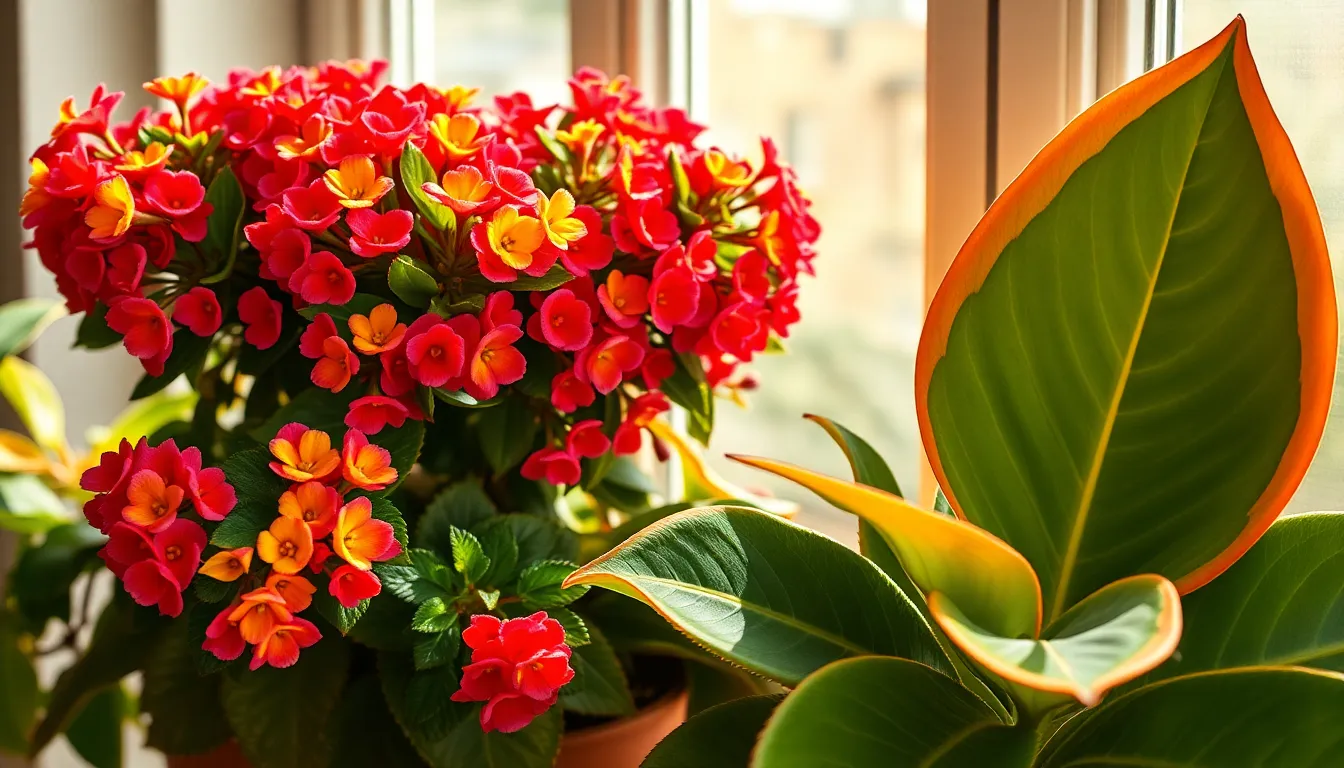
We explore the Kalanchoe genus, where vibrant blooms meet stunning foliage in nature’s most captivating flowering succulents. These remarkable plants stand out among succulent varieties for their ability to produce long-lasting, colorful flowers while maintaining the low maintenance characteristics we love about succulents.
Flaming Katy (Kalanchoe Blossfeldiana)
Flaming Katy transforms any indoor space with its spectacular clusters of vibrant flowers that bloom for months at a time. We recommend this popular houseplant for its ability to produce brilliant red, pink, yellow, or orange blooms that create stunning focal points in our homes. Bright indirect light keeps this flowering beauty thriving indoors while protecting its delicate petals from harsh direct sunlight.
Care becomes effortless when we allow the soil to dry completely between waterings, typically every 7 to 10 days during the growing season. We’ve found that cooler nighttime temperatures around 60°F encourage more prolific blooming cycles. Pruning spent flowers immediately promotes continuous blooming and keeps our Flaming Katy looking fresh throughout its extended flowering period.
Panda Plant (Kalanchoe Tomentosa)
Panda Plant captivates us with its incredibly soft, velvety leaves that feel like touching plush fabric. We admire the silvery gray foliage adorned with distinctive brown edges that create a striking contrast reminiscent of a panda’s coloring. This fuzzy succulent grows slowly but steadily, reaching heights of 12 to 18 inches when given proper care.
Moderate watering suits this unique succulent best, as we water only when the top inch of soil feels completely dry to the touch. Bright light conditions help maintain the plant’s compact growth habit and enhance the beautiful contrast between the silver leaves and brown margins. We position our Panda Plants near sunny windows where they receive several hours of bright, filtered sunlight daily.
Mother of Thousands (Kalanchoe Daigremontiana)
Mother of Thousands earns its fascinating name through its remarkable ability to produce tiny plantlets along the serrated edges of its broad, succulent leaves. We watch in amazement as these baby plants develop roots while still attached to the parent leaf, creating a living nursery that ensures effortless propagation. The plant’s upright growth pattern and spotted leaf coloration add architectural interest to our succulent collections.
Warm, sunny environments provide ideal growing conditions for this prolific propagator, as we place it in locations receiving 6 to 8 hours of direct sunlight daily. We collect the dropped plantlets regularly since they root easily in small pots filled with well-draining succulent soil mix. Careful handling prevents the many baby plants from spreading throughout our garden areas where they might become invasive.
Haworthia: The Window-Leaved Gems
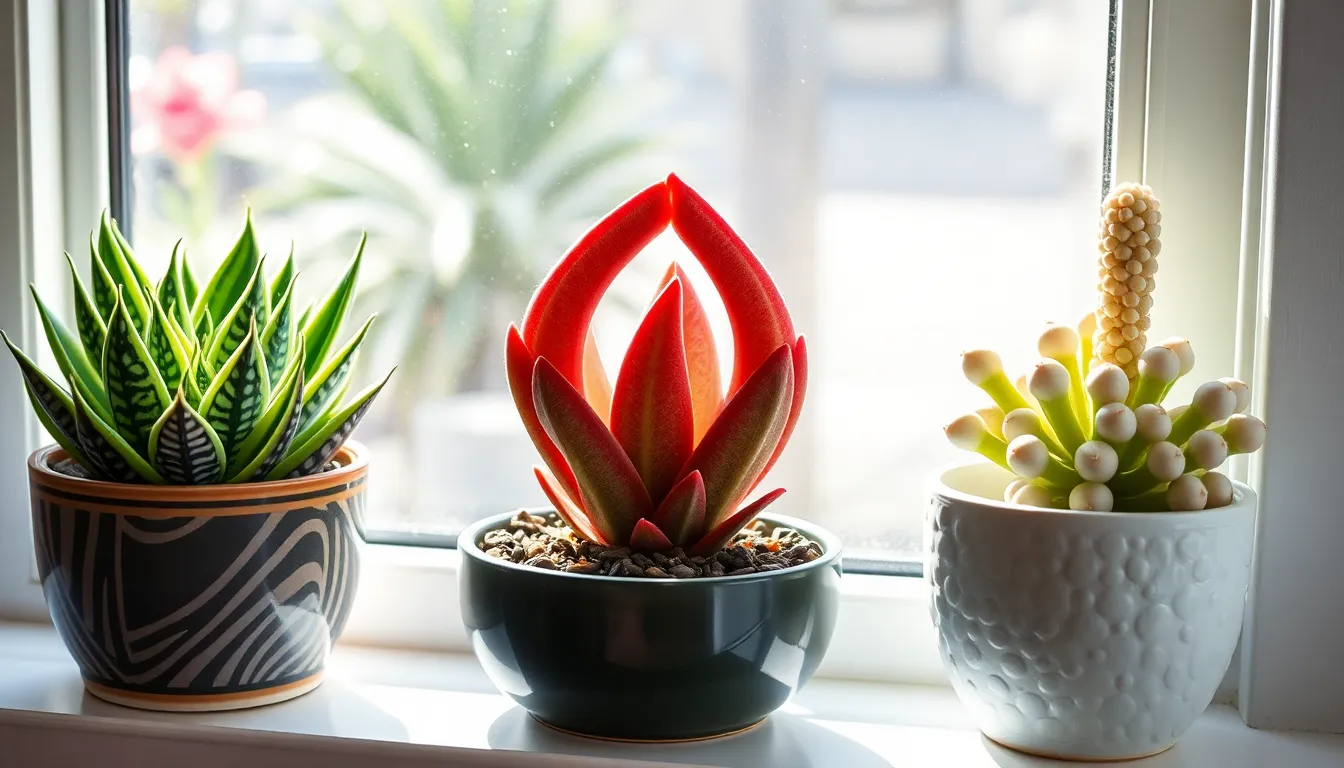
We’re now entering the intriguing area of Haworthia succulents, where nature’s artistry meets practical indoor gardening. These small rosette forming succulents from South Africa captivate us with their translucent “windows” that glow beautifully when backlit.
Zebra Haworthia (Haworthia Attenuata)
Zebra Haworthia displays pointed dark green leaves adorned with white tubercles arranged in horizontal bands that create stunning zebra stripe patterns. This recognizable variety stands out as one of the most popular Haworthias for indoor cultivation due to its striking appearance and forgiving nature.
Growing this beauty requires bright but indirect light to prevent leaf burn while maintaining its vibrant coloration. We recommend placing it near an east facing window where it’ll receive gentle morning sun without harsh afternoon rays.
Watering should occur only when the soil feels completely dry, typically every 2-3 weeks during growing season. Well draining soil prevents root rot, which can quickly damage these water storing plants.
Temperature preferences range from 65-80°F, making most indoor environments perfectly suitable for year round growth. During winter months, we reduce watering frequency to once monthly as the plant enters dormancy.
Cathedral Window (Haworthia Cymbiformis)
Cathedral Window features curved thick leaves that resemble stained glass windows with their pale green to light translucent surfaces. Named for its architectural leaf shape, this variety forms compact rosettes that add elegance to any succulent collection.
Positioning this plant in partial shade helps maintain its delicate translucent quality while preventing sun damage. Unlike many succulents, Cathedral Window actually tolerates lower light conditions better than most varieties.
Soil drainage remains critical for healthy root development, so we always use cactus exact potting mix combined with perlite. This combination ensures excess water flows freely through the container.
Propagation occurs naturally through offsets that develop around the base of mature plants. We carefully separate these baby plants when they reach one third the size of the parent rosette.
Monthly fertilizing during spring and summer with diluted cactus fertilizer supports steady growth without overwhelming the plant’s natural rhythm.
Pearl Plant (Haworthia Margaritifera)
Pearl Plant showcases rough pearl like tubercles scattered across its broad triangular leaves, creating a distinctive textured appearance that resembles tiny pearls. This species offers visual interest through its unique surface texture rather than translucent windows.
Light requirements include bright indirect sunlight to maintain the pronounced tubercle formation that gives this plant its common name. Direct sun can fade the contrasting patterns that make it so appealing.
Watering frequency follows the typical Haworthia schedule of deep but infrequent sessions when soil becomes completely dry. We check soil moisture by inserting our finger two inches deep into the potting medium.
Space considerations make this variety perfect for small containers since mature plants rarely exceed 4 inches in diameter. Desktop displays, windowsill gardens, and terrarium arrangements all benefit from its compact growth habit.
Seasonal care adjustments include reducing water during winter months and increasing humidity slightly during dry indoor heating seasons. A small pebble tray filled with water near the plant helps maintain optimal moisture levels.
Lithops: The Living Stone Mimics
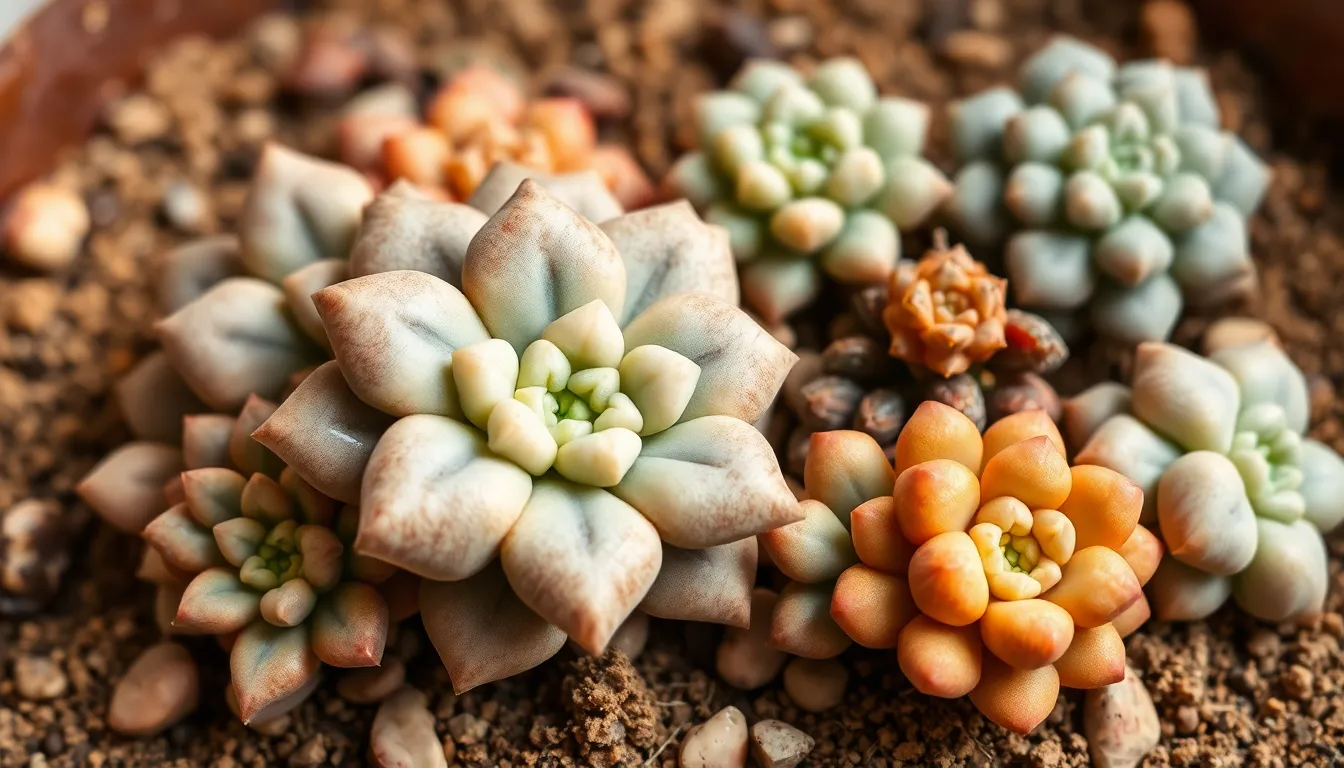
Lithops represent nature’s ultimate camouflage artists in the succulent industry. These remarkable plants have evolved to perfectly mimic stones and pebbles, making them nearly impossible to distinguish from their rocky surroundings.
Living Stones Basic Varieties
Living stones cover diverse species that differ dramatically in pattern and color variations. We’ve discovered that these small succulents feature split pair leaf structures that create fascinating geometric patterns across their surfaces. Each variety displays unique markings ranging from subtle earth tones to vibrant patterns that mimic different types of rocks and minerals.
Different species showcase distinct characteristics in their camouflage abilities. Some varieties feature smooth, mottled surfaces that replicate river stones, while others display intricate network patterns resembling cracked desert rocks. The diversity within basic Lithops varieties makes them incredibly sought after by collectors who appreciate their subtle beauty and remarkable adaptation strategies.
Split Rock (Pleiospilos Nelii)
Split rocks earn their common name from their distinctive rock like appearance with pronounced fissures between leaf pairs. We’ve found that Pleiospilos nelii creates an almost perfect illusion of a cracked stone sitting in the soil. These succulents develop thick, fleshy leaves that split down the middle, creating a natural divide that enhances their stone mimicking abilities.
Unlike other Lithops varieties, split rocks tend to be slightly larger and more dramatic in their appearance. Their leaves often display granite like textures and coloring that changes subtly with the seasons. The fissure between the leaf pairs serves as both a distinctive identifying feature and a functional adaptation that helps the plant blend seamlessly into rocky environments.
Flowering Stone (Lithops Aucampiae)
Flowering stones combine the classic stone like appearance with remarkable flower producing capabilities. We’ve observed that Lithops aucampiae produces bright, daisy like blooms that emerge dramatically from between the leaf pairs during their flowering season. These flowers create a stunning contrast against the muted, stone colored foliage.
The flowering process transforms these living stones into miniature garden spectacles. Blooms typically appear in late fall, creating vibrant yellow or white flowers that seem to magically appear from what looks like an ordinary pebble. This species demonstrates exceptional drought tolerance while maintaining its stone camouflage appearance throughout most of the year, making it a perfect choice for collectors seeking both visual interest and low maintenance care requirements.
Sempervivum: The Cold-Hardy Houseleeks
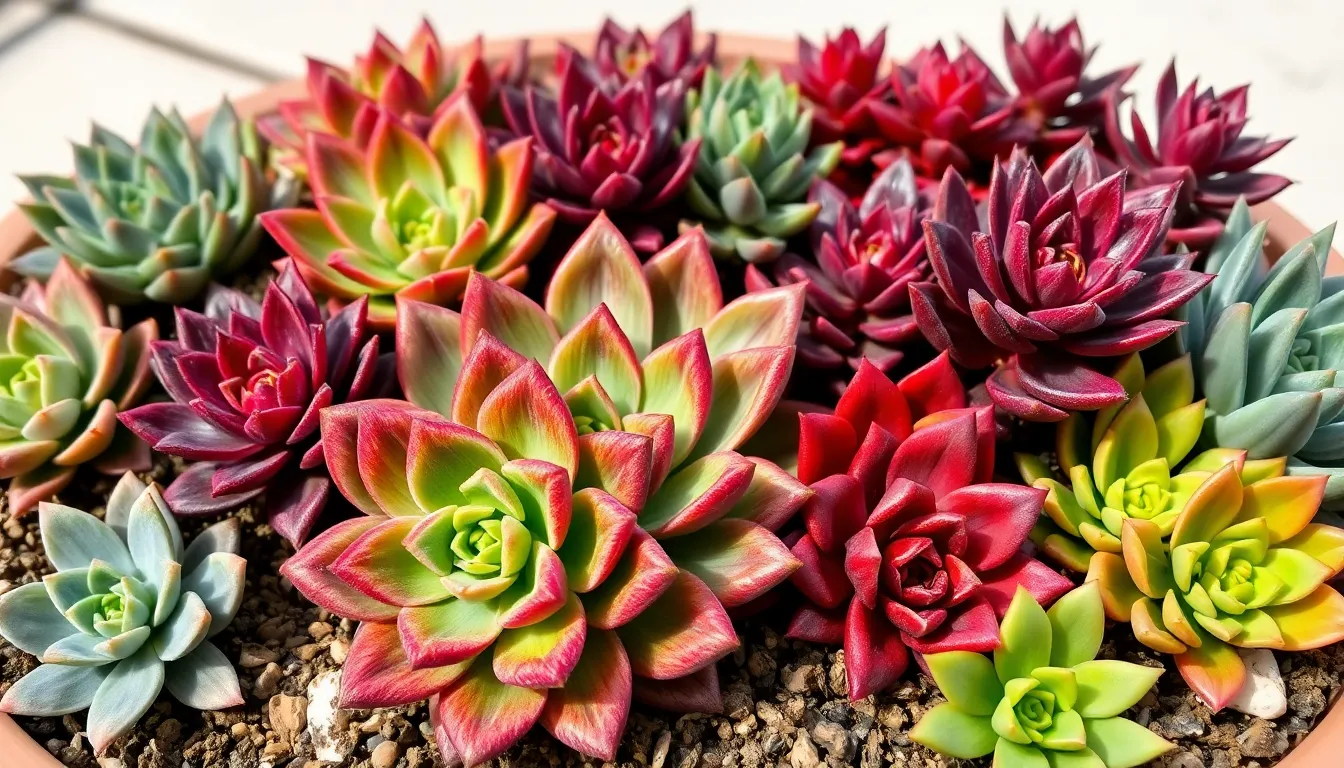
Sempervivum species stand out among succulents for their exceptional cold hardiness and ability to thrive in harsh outdoor conditions year-round. We particularly appreciate these houseleeks for their tight rosette formations and resilience to frost, making them perfect additions to rock gardens and outdoor containers.
Common Houseleek (Sempervivum Tectorum)
Common Houseleek represents the classic sempervivum species that’s been cultivating traditional roof gardens for centuries. This variety forms tight rosettes of green to reddish leaves that create stunning visual displays throughout the seasons. Star-shaped flowers emerge from mature plants, adding delicate blooms to complement the sturdy foliage.
Resilience defines this species’ character, as it withstands both frost and drought conditions with remarkable ease. We recommend planting Common Houseleek in well-drained soil with full sun exposure for optimal growth. Outdoor year-round cultivation becomes effortless due to its natural hardiness, requiring minimal maintenance once established.
Cobweb Houseleek (Sempervivum Arachnoideum)
Cobweb Houseleek earns its distinctive name from the fine white web-like hairs covering the center of each rosette. These delicate filaments create an ethereal appearance that sets this species apart from other sempervivum varieties. Even though its fragile looks, this houseleek maintains the same cold-hardiness traits that define the genus.
Decorative texture becomes the hallmark of this unique succulent, adding visual interest to any collection. We find that the web-like covering provides natural protection while creating stunning contrast against the green rosettes below. Low water requirements make this variety equally suitable for drought-prone areas and neglectful gardeners alike.
Red Beauty (Sempervivum Calcareum)
Red Beauty showcases deep red or burgundy rosettes that provide striking color contrast in succulent arrangements. This variety’s intense coloration becomes more pronounced in cooler temperatures, creating dramatic seasonal displays. We often use Red Beauty as accent plants to add bold color focal points to garden designs.
Cold climate performance remains exceptional for this drought-tolerant variety, sharing the hardy traits typical of all Sempervivum plants. Burgundy hues intensify during winter months, offering year-round visual appeal that many other succulents cannot match. Gardeners appreciate how Red Beauty maintains its vibrant coloration while requiring virtually no winter protection in most climates.
Conclusion
We’ve explored an incredible variety of succulent species that can transform any gardening experience. From the elegant rosettes of Echeveria to the stone-mimicking Lithops each genus offers unique characteristics that cater to different preferences and growing conditions.
These resilient plants prove that you don’t need extensive gardening knowledge to cultivate stunning displays. Whether you’re drawn to the healing properties of Aloe or the cold-hardy nature of Sempervivum there’s a perfect succulent waiting to thrive in your care.
Start your succulent journey today and discover how these remarkable plants can bring lasting beauty and satisfaction to your indoor or outdoor spaces.
Frequently Asked Questions
What makes succulents so popular among gardeners?
Succulents have gained popularity due to their low-maintenance nature and stunning aesthetic appeal. Their ability to store water in thick leaves and stems makes them extremely drought-tolerant and perfect for busy gardeners. They thrive in various environments and require minimal care while providing beautiful visual interest to any space, making them ideal for both beginners and experienced plant enthusiasts.
Which Echeveria varieties are best for beginners?
The Ghost Plant (Echeveria Lilacina), Hens and Chicks (Echeveria Elegans), and Black Prince (Echeveria Black Prince) are excellent choices for beginners. These varieties feature captivating rosette formations resembling blooming roses and are known for their ease of growth. They require minimal care and can tolerate various conditions while maintaining their beautiful appearance.
What are the most adaptable Sedum varieties?
Sedum varieties are incredibly hardy and adaptable to diverse climates. The Jade Plant (Sedum Rubrotinctum), Burro’s Tail (Sedum Morganianum), and String of Pearls (Sedum Lineare) are particularly versatile options. These succulents showcase excellent visual appeal while thriving in different environmental conditions, making them perfect for various gardening situations and climate zones.
Which Aloe plants offer both beauty and practical benefits?
Aloe Vera (Aloe Barbadensis) is renowned for its healing properties and skincare benefits. The Zebra Plant (Haworthia Fasciata) and Tiger Tooth Aloe (Aloe Juvenna) combine decorative appeal with easy care requirements. These varieties not only enhance your space aesthetically but also provide practical uses, particularly Aloe Vera’s well-known medicinal applications for skin treatments.
What makes Haworthia succulents unique?
Haworthia succulents are distinctive for their small rosette formations and translucent “windows” in their leaves. Varieties like Zebra Haworthia (Haworthia Attenuata), Cathedral Window (Haworthia Cymbiformis), and Pearl Plant (Haworthia Margaritifera) feature striking patterns and textures. They’re perfect indoor plants that tolerate lower light conditions while maintaining their captivating architectural appearance.
How do Lithops survive in harsh conditions?
Lithops, known as Living Stones, have evolved to mimic stones and pebbles, making them nearly invisible to predators. Their unique split-pair leaf structures and geometric patterns help them blend seamlessly with their surroundings. Varieties like Split Rock (Pleiospilos Nelii) and Flowering Stone (Lithops Aucampiae) demonstrate exceptional drought tolerance and require minimal maintenance, making them fascinating additions to succulent collections.
Which succulents can survive freezing temperatures?
Sempervivum, or houseleeks, are exceptionally cold-hardy and can thrive outdoors year-round in harsh conditions. Common Houseleek (Sempervivum Tectorum), Cobweb Houseleek (Sempervivum Arachnoideum), and Red Beauty (Sempervivum Calcareum) can withstand frost and freezing temperatures. These varieties are perfect for rock gardens and cold climate landscaping while maintaining their beautiful rosette formations.
What care do most succulents require?
Most succulents require well-draining soil, bright indirect light, and infrequent watering. Allow soil to dry completely between waterings, typically every 1-2 weeks depending on climate and season. Avoid overwatering, which is the most common cause of succulent death. Most varieties prefer temperatures between 60-80°F and benefit from good air circulation around their leaves.

